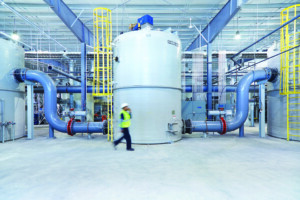Challenge
A 25-year undertaking, the remediation and restoration of the Onondaga Lake Superfund site in central New York is one of the largest and most complex remediation programs in the United States.
The Onondaga County (Lake) cleanup and restoration program, which was completed under supervision of the New York State Department of Environmental Conservation (NYSDEC) and the US Environmental Protection Agency (EPA), included the removal of approximately two million cubic yards of sediment. The hydraulically dredged sediment from the lake was first pumped to a sediment-processing area (SPA), and then to a sediment-consolidation area (SCA) for dewatering by geotube and long-term isolation. The effluent from the SPA and SCA was pretreated in the
SCA watertreatment plant (WTP); and then discharged for final polishing (removal) of ammonia and phosphorous at the municipal publicly owned treatment works (POTW). The SCA WTP was a critical component of the lake dredging program, as its design and construction were the critical path to the initiation of lake dredging operations.
Approach
Ramboll was responsible for the design, construction, and operation of the 6.5 mgd sediment-consolidation area water treatment plant. During the implementation of this dynamic project, key considerations included:
• The treatment of mercury to meet 50-ng/L effluent limits,
• Enhancement of the project schedule to allow lake dredging operations to commence as soon as possible
• Adaptive changes during dredging operations to address the highly variable nature of the dredged material.
As an alliance partner with Honeywell, Ramboll provides leadership for the 15 uplands subsites, which are part of the Onondaga Lake Superfund site. In addition, Ramboll is the water management and treatment lead for all the Onondaga Lake sites. An industry leader in dredging-related water management and project delivery, Ramboll provided bench-scale treatability testing, design, construction, commisioning and start-up services, as well as operations and maintenance services for the SCA WTP.
• Building on bench-scale testing performed by Ramboll as part of the conceptual design, the SCA WTP consistently met the 50 ng/L effluent limit for mercury, using pH adjustment and chemical co-precipitation.
• Through early issuance of design packages to facilitate equipment procurement and site work, Ramboll was able to shorten the design and construction schedule by two months. This, along with adaptive strategies during construction of the WTP, allowed the initiation of lake dredging operations ahead of schedule.
• Adaptive changes during WTP operation and dredging included:
- Ramboll was able to develop a field test, using kaolin clay, to quantify excess polymer in the influent, significantly reducing polymer usage in the SPA and minimizing polymer carryover to the SCA WTP.
- Ramboll was able to negotiate effluent limits for direct discharge from the SCA WTP during wet weather events at the municipal POTW. This adaptive change prevented the resulting suspension of dredge operations during combined sewer overflow events and was a key factor in completing dredging a year ahead of schedule.
Results
A high level of coordination among the owner, local municipality, and NYSDEC was required to implement the project successfully. The project was completed ahead of schedule and under budget. In addition, the project has brought significant improvements to water quality, aiding in the return of native plants and animals and helping to restore the habitat of Onondaga Lake.
This project received a Western Dredging Association (WEDA) Annual Safety Award for its outstanding safety record and performance.


